 by Barent W. Walsh
by Barent W. Walsh
Practitioners gain a wealth of knowledge about the variety and causes of self-injurious behavior and how to recognize it in people at risk, ranging from those who do not have psychiatric diagnoses to those with eating or mood disorders, posttraumatic stress disorder, personality disorders, or psychoses.
Full Description:
Uniquely practical and comprehensive, this timely guide addresses a problem that is on the rise, particularly among adolescents and young adults. Practitioners gain a wealth of knowledge about the variety and causes of self-injurious behavior and how to recognize it in people at risk, ranging from those who do not have psychiatric diagnoses to those with eating or mood disorders, posttraumatic stress disorder, personality disorders, or psychoses. Illustrated with detailed case examples, clear guidelines are presented for assessing clients and conducting evidence-based interventions using replacement skills training, cognitive-behavioral therapy, exposure treatment, psychopharmacology, and family- and school-based strategies. Reproducible clinical materials are included.
"Walsh delivers a wise and thoughtful set of directives for reaching those who self-harm. He clearly defines their dynamics and constructs an assessment and treatment strategy that is sound and empirically based. This book deserves every clinician's attention."
-Alan L. Berman, PhD, Executive Director, American Association of Suicidology
"When I asked my seminar of school psychologist interns how many were presently working with young people who self-injure, every hand in the room went up. This excellent, well-organized text has given my graduate students strategies for assessment, intervention, and management of self-injury that will likely be well utilized in daily professional practice."
-Joy E. Fopiano, EdD, Program and Clinical Coordinator, School Psychology, Southern Connecticut State University
317 Pages, Size: 6" x 9"
I. Definition and Contexts
1. Definition, Differentiation from Suicide, and Classification
2. An Overview of Direct and Indirect Self-Harm
3. Major Groups in Which Self-Injury Occurs
4. Body Piercing, Tattooing, Branding, Scarification, and Other Forms of Body Modification
II. Assessment and Treatment
5. A Biopsychosocial Model for Self-Injury
6. Initial Therapeutic Responses
7. Cognitive-Behavioral Assessment
8. Contingency Management
9. Replacement Skills Training
10. Cognitive Treatment
11. Body Image Work
12. Exposure Treatment and Resolution of Trauma
13. Family Treatment
14. Psychopharmacological Treatment, Gordon Harper
15. Managing the Reactions of Therapists and Other Caregivers to Self-Injury
III. Specialized Topics
16. Contagion and Self-Injury
17. A Protocol for Managing Self-Injury in School Settings
18. Treating Major Self-Injury
Conclusion
Afterword
Appendix A. Breathing Manual
Appendix B. Body Attitudes Scale
Appendix C. Websites Related to Self-Injury
Appendix D. Bill of Rights for People Who Self-Harm
Stock: Usually ships in 8-10 business days!
|